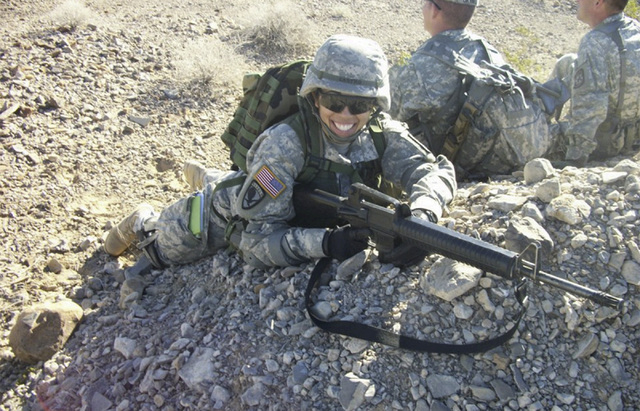Army combat officer’s job in female UNLV student’s future

Like the cannons she will be firing in field artillery training this summer, Camille Castro has her sights set high for being among the first women to integrate the officer ranks of an Army combat arms unit.
That role traditionally had been performed by men until the Pentagon launched an effort aimed at equal opportunity for female soldiers, sailors, Marines and Air Force personnel.
“I didn’t really want to be a pioneer,” Castro, 22, said in an interview Thursday between classes at the University of Nevada, Las Vegas, where she is a senior political science major and an Army ROTC cadet major and the program’s executive officer.
“I wanted to do my job and do it well, but I figured because it’s so new and up-and-coming for females I would experience it because it’s just opening up to females,” she said.
After graduation with a commission as a second lieutenant, she will head for Fort Sill, Okla., in July to learn about aiming and firing artillery pieces including the Paladin, a tanklike 155mm howitzer. Through November she will endure an officer leadership course to groom her for the artillery military occupational specialty known as 13 Alpha.
“My goal right now is to do my four years the best I can to reach the rank of captain,” she said. “The Army means a lot to me but not everything. I want to get married and have a family.”
In January 2013, outgoing Defense Secretary Leon Panetta announced the military would implement a policy with the plan fully in place by 2015 that potentially will open the doors for women to serve in combat units such as the Army Rangers, Special Forces and infantry combat teams if they pass the same muster as men for those units.
The plan calls for the Pentagon to open to women combat positions that have been off-limits under a 1994 rule that had banned them from being assigned to smaller, elite ground combat units. By January 2016 all combat jobs must be open to women or the military must explain why any will remain open to men only.
Castro, whose father, George Castro, served in the Marine Corps and is a retired Las Vegas police lieutenant, said she is not gung-ho about the idea of women in combat infantry roles because of natural tendencies for men to protect women.
“I’m for a lot of other females that are extremely confident. But maybe they don’t need to hold a gun in hand and are able to play a significant role like field artillery and MPs,” she said.
Nevertheless, she feels women who can pass the physical requirements and have the desire to serve in certain combat roles should have the opportunity as long as they can meet the Army’s expectations.
“I feel like perception is important. Perception is everything,” she said. “How you look and carry yourself. You need to be confident and competent. Whatever you want to be as an asset in the Army, be confident.”
In 2012, roughly 205,000 women were members of the U.S. active duty military force, 14.5 percent, compared to more than 1,206,000 men, according to the Defense Manpower Data Center.
In the military’s reserve component in 2012, women accounted for a higher percentage, 18 percent, or 153,915 women, vs. 82 percent men, or 701,948.
This year, the U.S. Military Academy at West Point, N.Y., is hoping to increase the number of female applicants to boost the number of women cadets beyond 16 percent. The number has hovered at less than one out of five cadets since females were first enrolled in the nation’s military academies in 1976.
The effort to train women for combat roles comes as Defense Secretary Chuck Hagel said the military will begin drawing down its personnel numbers as U.S. combat troops finish withdrawing from Afghanistan by the end of this year.
The Pentagon plans to reduce the Army to 490,000 troops, down from a peak of 570,000 after the Sept. 11, 2001, terrorist attacks. The Defense Department’s forecast calls for reducing the Army over the next few years to between 440,000 and 450,000 soldiers, the lowest level since 1940.
Castro graduated from a magnet school, Northwest Career Technical Academy, and played softball and tennis for Centennial High School before attending UNLV. She has maintained a 3.6 grade-point average in college while minoring in military science under the ROTC program and completing grueling Ranger Challenge training courses in Coronado, Calif., and in March at Joint Base Lewis-McChord, Wash.
Her advice to young women who want to become soldiers: “Work hard. Be confident. Be flexible. Strive for greatness every day. Learn from your mistakes and just have fun.”
Contact Keith Rogers at krogers@reviewjournal.com or 702-383-0308. Find him on Twitter: @KeithRogers2.